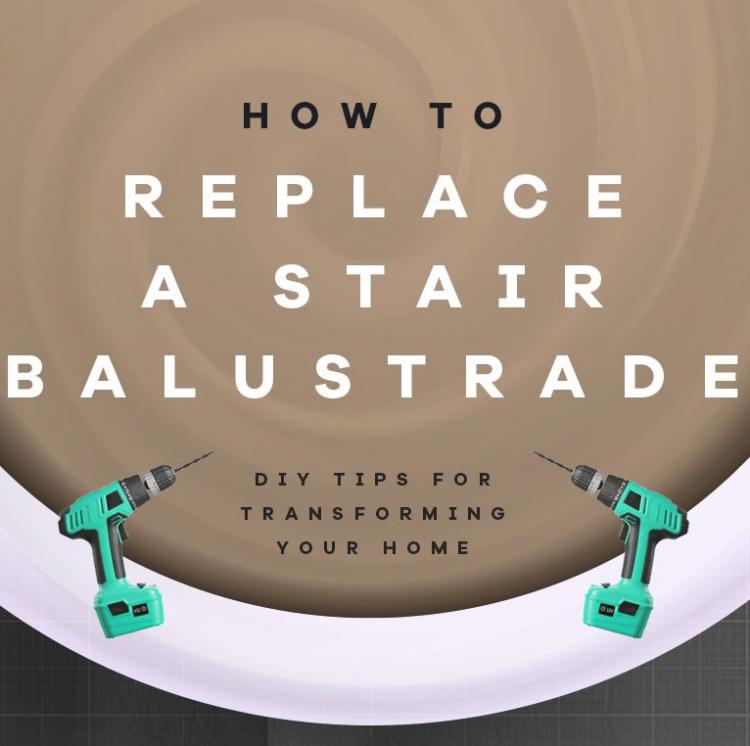
Updating your 70s staircase has never been so easy...
Replacing your stair spindles, newel posts and rails doesn't need to be difficult. If your stairs are looking old and have fallen deeply into despair, replacement stair balustrade will definitely help kick-start your home renovations and make your hallway a pleasant sight once again. Changing your stair balustrade (handrails, base rails, spindles and newel posts) doesn't always need to be difficult; it can be undertaken as a DIY project if you are used to working with wood. Certain systems are easier to fit as a stair DIY project than others depending on the way the pieces are held together. We recommend Metal and Glass Stair Parts by Cheshire Mouldings. Check out our easy-to-follow, helpful guide on how to replace your stair spindles, newel posts and rails below:
For more specific information or help regarding our balustrade/staircase products, please don't hesitate to get in touch with a member of our expert sales team on 01691 671020 for further assistance. Updating your 70s staircase has never been so easy...
1 - A Quick Guide
1a - Understanding Your Staircase

Base rail -When you are thinking of your stair design, the base rail is likely to be far from your thoughts. A base rail is a small but important part of the design process. Not only does it add a finishing touch, but is also an essential safety feature that ensures that your stair spindles are securely held in position.
Handrail - A handrail is the rail that runs along the top of the spindles. Handrails can also be attached to the wall as a stand-alone fitting. Their main purpose is& o be grasped by the hand of the user so as to provide stability and support.
Newel caps -Situated on top of a newel post, newel caps are the perfect finishing touch to a staircase.
Newel posts -A newel post is the structural upright post that fits at the beginning and the end of a staircase and supports the handrail of a stair banister. The most important job of a newel post is to provide structural support, but that does not mean that they can't be used to enhance the look and feel of your stairs.
Stair spindles - The spindles that you choose for your staircase can have a huge impact on the overall look of your home. Spindles are the vertical struts that connect the handrail to the base rail of your staircase.
Not sure on how many stair spindles you need? Check out our simple stair spindle spacing guide here.
Risers - The board that forms the face of the step.
Tip: The maximum individual rise for domestic staircase flights is 220mm.
Treads - The top or horizontal surface of a step.
Bullnose step - Typically at the bottom of the staircase with one or both ends of the step having a quarter circle design.
Going - The going of a flight of stairs is the horizontal distance between the face of the first and last risers.
Nosing - The edge of the tread projecting beyond the face of the riser and face of the cut string.
Cut or open string - A string with the upper edge cut away to the shape of the treads and risers so that their profile can be seen from the side.
Rise - The rise of a flight is the vertical distance between the floors or landings connected by the flight. The individual rise is the vertical measurement from the top of one tread to the top of an adjacent tread.
Winders - Are steps narrower at one end that are used to change the direction of the stairs through 90 or 180 degrees.
1b - Choosing a Style of Staircase

Chrome - For a fashionable and modern improvement in your home, why not invest in a chrome staircase. Both timber and metal are used to create a unique spindle for the staircase, as well as providing matching newel posts, hand and base rails and all the necessary assembly and finishing kits to make this installation a piece of cake.
Iron - If you want your home to be packed full of character and quirky features without renovating your entire home, then look no further. Both ranges of iron balustrade come with everything you need to give your staircase a fresh new appearance. We stock the iron spindles, solid oak base and handrails as well as newel posts and wood adhesive.
Contemporary - If you are looking for a clean cut, edgy look, then our Stop Chamfered range is perfect for someone seeking that squared off, timeless look.
Traditional - Renovate your staircase with understated Traditional Turned Spindles and Newel Posts for a classic unspoiled look. This range instantly revives and renews the look of your staircase to completely transform your home.
Glass panels - A simple and easy way to open up your home - making it feel brighter and more spacious - is by incorporating glass panels in your staircase. Forget traditional wooden spindles and opt for something a little more contemporary and modern for your home.
For more specific information or help regarding our balustrade/staircase products, please don't hesitate to get in touch with a member of our expert sales team on 01691 671020 for further assistance.
2 - Preparation
2a - Removing Your Existing Spindles and Handrail

1 and 2 - Housed & Housed and Nailed
- Carefully prise off the moulding covering the tread
- Knock the bottom end of the spindle sideways out of its housing
- Pull it downwards to disengage from the handrail housing.
3 - Housed at Both Ends
- Cut through the shoulder line of the joint on the underside of the handrail
- Pull your spindle out of the lower housing.
4 and 5 - Butt Jointed and Nailed
- Drive the top end of your spindle backwards and its bottom end forwards
- Once the top is freed, it can be pulled out of its housing.
Tip: If you wish to reuse the spindles, take care when removing as they may damage or snap.
6 - Removing Your Existing Handrail
- Undo the handrail bracket bolts (located near the newel posts)
- Lift your handrail clear when loose.
For more specific information or help regarding our balustrade/staircase products, please don't hesitate to get in touch with a member of our expert sales team on 01691 671020 for further assistance.
3 - Required Tools

3a - To Replace Stair Spindles, Newel Posts and Rails You Will Need the Following Tools...
- Safety goggles
- Sliding Bevel
- Handsaw
- Hacksaw
- PVA woodworking adhesive
- Drill
- Pencil
- Ruler
- Try square
- Spanner
- Paint or varnish
- Hammer
- Chisel.
4 - Step by Step / A Guide for Replacing Stair Spindles, Newel Posts and Rails
4a - Fitting Spigot Newel Posts

- To replace damaged or modified newel posts cut them off, leaving the joints between their bases and outer string intact
- Mark diagonal lines across the remaining cut ends to identify their centres
- Drill a hole into the centres of the remaining newel end
- Shape the cut ends of the old newel posts into a slightly convex contour
- Set the new posts on top of the cut newel, but don't glue them just yet.
For more specific information or help regarding our balustrade/staircase products, please don't hesitate to get in touch with a member of our expert sales team on 01691 671020 for further assistance.
4b - Fitting the Rails

- Use a sliding bevel to measure the angle of the stair string where it meets the base of the newel
- Following the angle of string, hold the base rail against the staircase, and mark each end where it meets the newel posts
- Using a sliding bevel and try square, mark out mitres at these points and cut the base rail to length
- Mark and cut the handrail in the same manner
- Screw the base rail to the string
- Using the handrail brackets, fit the handrail in place, taking up the slack with a spanner
- Check the newel posts are upright and the handrail and base rail both fit properly
- Glue the newel posts in place using a PVA woodworking adhesive (or if the joints are loose, use a gap-filling synthetic resin glue).
- Tighten the handrail bracket bolts
- (Once the glue has set) conceal the nuts using cover buttons.
4c - Fitting the Spindles

- Firstly, calculate how many spindles you will need - the general rule of thumb is to allow 2 spindles per tread, and one spindle for the treads adjacent to the newel posts / Tip: Your spindles should be placed no more than 4 inches apart
- Calculate the number of infill fillets you require by doubling the number of spindles and adding 4
- Measure the vertical distance between the grooves in the handrail and base rail - using the sliding bevel to mark this dimension on the spindle
- Cut the spindle to size and check the fit. When happy, repeat with the remaining spindles
- Pin and glue the spindles and pre-cut spacer fillets in place
- When the adhesive is set (if you are using bare wood) apply a finish of paint, coloured wood dye or clear varnish,
For more specific information or help regarding our balustrade/staircase products, please don't hesitate to get in touch with a member of our expert sales team on 01691 671020 for further assistance.
